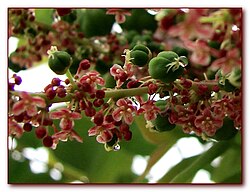| Phyllanthus | |
|---|---|
 | |
| Phyllanthus mirabilis | |
 | |
| Phyllanthus fluitans | |
| Scientific classification | |
| Kingdom: | Plantae |
| Clade: | Tracheophytes |
| Clade: | Angiosperms |
| Clade: | Eudicots |
| Clade: | Rosids |
| Order: | Malpighiales |
| Family: | Phyllanthaceae |
| Subfamily: | Phyllanthoideae |
| Tribe: | Phyllantheae |
| Genus: | Phyllanthus L. |
| Diversity | |
| About 800 species | |
| Synonyms [1] | |
List
| |





Phyllanthus is the largest genus in the plant family Phyllanthaceae. Estimates of the number of species in this genus vary widely, from 750 [2] to 1200. [3] Phyllanthus has a remarkable diversity of growth forms including annual and perennial herbs, shrubs, climbers, floating aquatics, and pachycaulous succulents. Some have flattened leaflike stems called cladodes. It has a wide variety of floral morphologies and chromosome numbers and has one of the widest range of pollen types of any seed plant genus.
Contents
- Species
- Selected species
- Fossil record
- Pollination biology
- Research and traditional medicine
- References
Despite their variety, almost all Phyllanthus species express a specific type of growth called "phyllanthoid branching" in which the vertical stems bear deciduous, floriferous (flower-bearing), plagiotropic (horizontal or oblique) stems. The leaves on the main (vertical) axes are reduced to scales called "cataphylls", while leaves on the other axes develop normally. [4] Phyllanthus is distributed in all tropical and subtropical regions on Earth.
Phyllanthus was first described by Carl Linnaeus in 1753, [5] [6] but the type was not designated. [5]